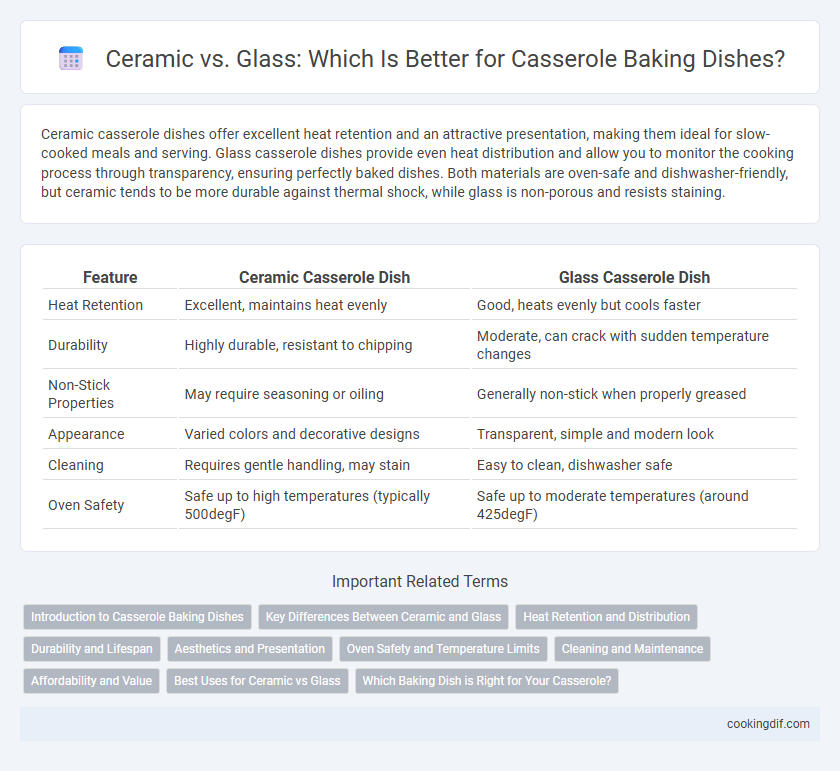Ceramic casserole dishes offer excellent heat retention and an attractive presentation, making them ideal for slow-cooked meals and serving. Glass casserole dishes provide even heat distribution and allow you to monitor the cooking process through transparency, ensuring perfectly baked dishes. Both materials are oven-safe and dishwasher-friendly, but ceramic tends to be more durable against thermal shock, while glass is non-porous and resists staining.
Table of Comparison
| Feature | Ceramic Casserole Dish | Glass Casserole Dish |
|---|---|---|
| Heat Retention | Excellent, maintains heat evenly | Good, heats evenly but cools faster |
| Durability | Highly durable, resistant to chipping | Moderate, can crack with sudden temperature changes |
| Non-Stick Properties | May require seasoning or oiling | Generally non-stick when properly greased |
| Appearance | Varied colors and decorative designs | Transparent, simple and modern look |
| Cleaning | Requires gentle handling, may stain | Easy to clean, dishwasher safe |
| Oven Safety | Safe up to high temperatures (typically 500degF) | Safe up to moderate temperatures (around 425degF) |
Introduction to Casserole Baking Dishes
Ceramic and glass casserole baking dishes both offer excellent heat retention and even cooking, essential for perfectly baked casseroles. Ceramic dishes provide superior insulation, maintaining warmth longer after removal from the oven, while glass allows easy monitoring of browning and doneness through its transparent surface. Choosing between ceramic and glass ultimately depends on preferences for heat distribution, visual cooking cues, and ease of cleaning.
Key Differences Between Ceramic and Glass
Ceramic casserole dishes provide superior heat retention and even cooking due to their dense material, making them ideal for slow baking and serving. Glass baking dishes offer excellent visibility of the food during cooking and typically heat up faster, but they can be more prone to thermal shock and breakage. Both materials are oven-safe, but ceramics generally withstand higher temperatures, while glass is easier to clean and less likely to stain.
Heat Retention and Distribution
Ceramic casserole dishes excel in heat retention, maintaining consistent warmth long after being removed from the oven, which helps keep food hot during serving. Glass casseroles offer superior heat distribution, allowing even cooking without hot spots due to their ability to transmit heat efficiently throughout the dish. Choosing between ceramic and glass depends on whether long-term heat retention or uniform cooking is prioritized in casserole baking.
Durability and Lifespan
Ceramic casserole dishes offer excellent heat retention but can be prone to chipping or cracking under sudden temperature changes, impacting their durability. Glass casserole dishes generally provide greater resistance to thermal shock and maintain structural integrity over long-term use, contributing to a longer lifespan. Choosing between ceramic and glass depends on careful handling and desired durability for frequent baking tasks.
Aesthetics and Presentation
Ceramic casserole dishes offer a rustic, handcrafted appearance with rich, opaque colors that enhance table presentation and withstand high oven temperatures without sacrificing style. Glass baking dishes provide a sleek, transparent look, allowing diners to see the dish's layers, which adds visual appeal and helps monitor cooking progress. Choosing between ceramic and glass hinges on desired aesthetics: ceramic emphasizes warmth and traditional charm, while glass highlights modern elegance and functionality.
Oven Safety and Temperature Limits
Ceramic casserole dishes offer excellent oven safety with high heat tolerance, typically up to 450degF (232degC), making them ideal for slow baking and roasting. Glass baking dishes generally withstand temperatures up to 425degF (218degC) but can be prone to thermal shock if exposed to sudden temperature changes. Choosing ceramic ensures greater durability and consistent heat distribution during high-temperature oven use.
Cleaning and Maintenance
Ceramic casserole dishes often feature a non-porous surface that resists staining and retains heat well, making them relatively easy to clean with warm, soapy water and occasional baking soda scrubbing to remove baked-on residues. Glass casserole dishes, particularly borosilicate glass, are dishwasher safe and less prone to absorbing odors or flavors, providing a straightforward maintenance routine with minimal risk of discoloration. Both materials benefit from avoiding sudden temperature changes to prevent cracking, but glass offers superior transparency for monitoring cooking progress without lifting the lid.
Affordability and Value
Ceramic casserole dishes generally offer better affordability compared to glass, making them a cost-effective choice for everyday baking needs. Their excellent heat retention provides consistent cooking performance, enhancing value by reducing the risk of unevenly cooked dishes. Glass casseroles, while slightly pricier, offer the advantage of non-porous surfaces that resist staining and odor retention, contributing to long-term durability and overall value.
Best Uses for Ceramic vs Glass
Ceramic casserole dishes excel at even heat retention and are ideal for slow-cooked recipes such as gratins, lasagnas, or casseroles that require consistent, gentle baking. Glass casserole dishes are preferred for recipes needing visual monitoring during cooking, like casseroles with layered ingredients or dishes that benefit from rapid heat distribution and easy cleaning. While ceramic is best for dishes that need gradual heat, glass is perfect for quick baking and reheating tasks in the oven or microwave.
Which Baking Dish is Right for Your Casserole?
Ceramic baking dishes excel at retaining heat and providing even cooking, making them ideal for slow-cooked casseroles that benefit from consistent warmth. Glass baking dishes offer the advantage of visibility, allowing you to monitor browning and doneness without opening the oven, and they heat up quickly, suitable for recipes requiring precise temperature control. Choosing between ceramic and glass depends on the casserole's cooking time and temperature sensitivity, as well as your preference for heat retention versus monitoring capabilities.
Ceramic vs Glass for casserole baking dish Infographic

 cookingdif.com
cookingdif.com